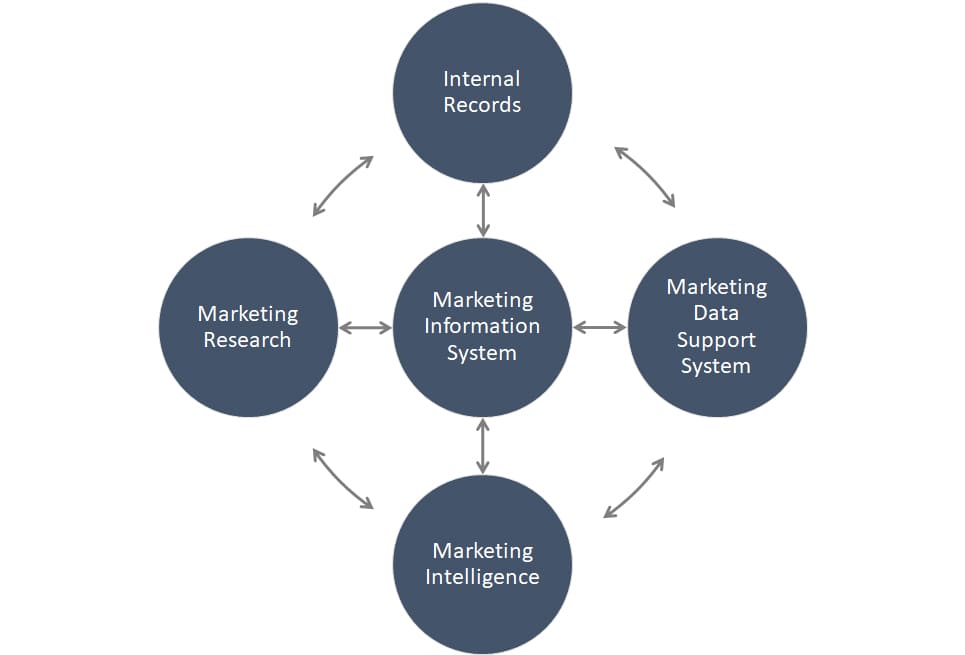Definition: A marketing information system (MIS) collects data from internal and external resources, stores it, analyzes it, and provides organizations with meaningful output on a regular basis so they can make informed decisions.
With a marketing information system, businesses can make an informed decision on new product launches, marketing strategies, product pricing, product promotions, etc.
Data has a key role in a marketing information system. An organization can get data from different sources, such as:
- Internal Data
- External Data
- Market Research
Internal Data: The organization can have an internal database. This data can be from previous sales, marketing activities, lead collection, etc. This data is very useful for MIS.
External Data: External data is the data acquired from external resources. Many consultancies and market research firms sell data, and organizations can purchase it for their marketing purposes. Organizations can also purchase some government data to study demographic or economic information.
Market Research: The organization can conduct market research or hire third parties to conduct surveys. These data are useful as they provide current and specific data the organization is looking for.
Importance of Marketing Information System
Businesses always need to improve their products and services to stay ahead of the competition. An MIS system helps them achieve this objective. It helps manage marketing campaigns for an organization. It provides organizations with valuable information on which they can base their decisions.
MIS is a good communication tool that keeps all stakeholders on the same page. It removes the guesswork from decision marking and creates objectivity.
Some benefits of using marketing information systems are:
- Better information on competitors’ products
- Better information on competitors’ strategy
- Identifies business risks
- Helps in-demand supply analysis
- Helps get customers’ feedback to incorporate it into the product
- Improves productivity
- Improves the organizational communication
- Improves customer satisfaction
- Implements customer-friendly processes
Marketing Information System Components

A marketing information system has four components:
- Internal Records
- Marketing Data Supports System
- Marketing Intelligence
- Marketing Research
Internal Records
Internal records are reports created by managers for top management to communicate the status, progress, or updates on internal processes. These reports provide actual information on the organization’s strengths and weaknesses.
The internal records include:
- Sales data
- Cash flows
- Product costs
- Profit reports
- Employees costs
- Expenses
- And more
Marketing Data Supports System
A marketing data support system includes software systems that organizations use to streamline marketing information systems. The software can be a standalone system or a combination of multiple software.
This software includes various statistical tools to help businesses carry out data analysis.
Marketing Intelligence
Marketing intelligence provides information on current market conditions. It includes collecting data from external resources such as consultancies, research firms, and trade unions and using this information to understand the market and competition.
Examples of marketing intelligence are:
- Current market conditions
- Current trends
- Market competition
- Product pricing
To have an efficient marketing information system, an organization must have the best marketing intelligence. Businesses can employ many tactics to get market intelligence, such as using competitors’ products, using distribution channels to get information on the competition, using various growth strategies, etc.
Market Research
Market research is the best method of getting current data based on organizational requirements. Organizations usually hire third-party services to conduct market surveys. The survey can include specific questions, or it can ask for open feedback on the organization’s product or services or the competitors’ services.
Market research is useful when a business wants to launch a new product and wants to gather customers’ requirements and expectations. Based on the information collected from the market research, they can design or tweak the product.
Market research can provide information on the following:
- Customer feedback
- Current market conditions
- Customers’ requirements
- Competitors’ products
- And more
With market research, businesses can learn more about consumers’ problems and then offer better solutions. They can also understand how competitors are tackling the consumers’ issues.
Example of a Marketing Information System
These days, most clothing retailers offer brand loyalty cards. These cards record all the information about users’ purchase history and patterns.
Based on the pattern, clothing companies offer customized offers to consumers. Consumers can get the best offer and collect rewards on each purchase. Once they accumulate a certain number of reward points, they can cash them in with any store affiliated with the clothing brand.
Another example is booking.com, which stores the visitors’ visit patterns and choices of hotels. Based on this history, they can offer the best choices to consumers.
Summary
Every business intends to grow its sales, and a marketing information system has a key role in achieving this objective. It provides organizations with essential information that they can use to make strategic decisions and develop growth plans.
